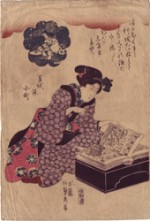
In the year 1008, Murasaki Shikibu, a lady-in-waiting serving at the Japanese imperial court, wrote in her diary of the feverish excitement surrounding the distribution of her story, now known as The Tale of Genji. Demand was so high that a group of women was assigned the task of producing multiple copies under Murasaki’s direction. Today, in 2008 as we celebrate the 1000-year anniversary of the writing of this, the world’s first novel, the story has been translated into over 30 languages, including several versions in modern Japanese, and has sold tens of millions of copies in modern print worldwide. On October 19th and 25th, the Canadian Society for Asian Arts and UBC Museum of Anthropology will recognize the contributions of The Tale of Genji not only to Japanese culture but to world culture through two special programs.
Sunday, October 19, 2:00 pm
Lecture: “The Tale of Genji and the Making of Modern Japanese Femininity” By Dr. Joshua Mostow, Department of Asian Studies, UBC
Saturday, October 25, 2:00 pm
Performance: Enchantment of Genji: Music Inspired by Poems from The Tale of Genji
Featuring Alcvin Takegawa Ramos on biwa and shakuhachi
and Satomi Saeki on koto
Both programs are open to the public. Admission is by donation.
Asian Illuminations Lecture: “The Tale of Genji and the Making of Modern Japanese Femininity”

By Dr. Joshua Mostow, Department of Asian Studies, UBC
Sunday, October 19, 2008 at 2:00 pm
at the Royal Bank Cinema, Chan Centre for Performing Arts, UBC
Followed by a special reception with the speaker.
This talk will explore how women were exposed to the Tale of Genji in the early modern period, especially through manuals of feminine etiquette. It will trace how this continued into the 20th century, despite the radical changes that transformed Japan, and the place of Genji in such pop culture genres as manga and anime.
Dr. Mostow is an internationally acclaimed specialist of classical Japanese literature and visual culture, with a particular focus on the interplay of text and image in pre-modern Japan. His Research interests include the inter-relations between text and image, especially in Japanese culture; Japanese women’s writing in the court tradition; the ideological construction of the Heian period in the modern era; Japanese “national erotics” (that is, the use of sexuality in cultural self-definition) At UBC he teaches undergraduate and graduate courses on premodern Japanese literature, in translation and in the original; premodern Japanese text and image inter-relations; classical Japanese language; Japanese women’s self-writing; post-colonial theory; Edo sexuality; Japanese film.
He is the sole author of Pictures of the Heart: The Hyakunin Isshu in Word and Image (University of Hawai’i Press, 1996) and At the House of Gathered Leaves: Shorter Biographical and Autobiographical Narratives from Japanese Court Literature (University of Hawai’i Press, 2004); co-author, with Henk Herwig, of The Hundred Poets Compared: A Print Series by Kuniyoshi, Hiroshige, and Kunisada (Hotei, 2007); and, With Royall Tyler, of a new translation of Tales of Ise. He is co-editor, with Norman Bryson and Maribeth Graybill, of Gender and Power in the Japanese Visual Field (Hawai’I, 2003); and with Catherine Vance Yeh and Doris Croissant, of Performing “Nation”: Gender Politics in Literature, Theatre, and the Visual Arts of China and Japan, 1880-1940 (Brill, 2008). He was the General Editor of the prize-winning Columbia Companion to Modern East Asian Literature (2003).
Enchantment of Genji: Music Inspired by Poems from The Tale of Genji
Featuring Alcvin Takegawa Ramos on biwa and shakuhachi
and Satomi Saeki on koto
With poetry from the Tale of Genji in English translation and original Japanese
Saturday, October 25, 2008 at 2:00 pm
at the National Nikkei Heritage Centre, Ellipse Lobby, 6688 Southoaks Crescent, Burnaby
Masters of traditional Japanese music, Alcvin Takegawa Ramos and Satomi Saeki offer moving new musical interpretations of the classic poetry of The Tale of Genji. Recitations of selected poems from the tale in both English and the original Japanese will provide inspirational links between their renderings of the themes of love, the seasons, solitude, and impermanence perfectly suited to the haunting sounds of shakuhachi, biwa, and koto.
Alcvin Takegawa Ramos was born in Kanagawa-ken, Japan, in 1969. His interest in eastern religions, martial arts and meditation inspired him to study the shakuhachi (bamboo flute) and its various musical styles including honkyoku (sacred Zen music), sankyoku (secular ensemble music) and gendai kyoku (contemporary pieces). Ramos received a shihan (master) license from Katsuya Yokoyama, a renowned master-teacher of the instrument and founder of the International Shakuhachi Training Centre in Japan.
Born in Miyazaki, Japan, Satomi Saeki was introduced to Japanese traditional music by her father, a shakuhachi-player and -maker. She studied koto (horizontal harp), sangen/shamisen (3-stringed Japanese lute) and juushichigen (17-stringed horizontal harp) with Shizu Watanabe, Namie Sano and Takeshi Nakai. Saeki graduated from the Tokyo Geijutsu Daigaku (National Tokyo University of Fine Arts and Music) and the 37th Japanese Traditional Music School of NHK (Japan Broadcasting Cooperation). Since moving to Victoria, British Columbia in 1994, Saeki has been teaching and performing koto music at various educational institutes and cultural events in North America.

